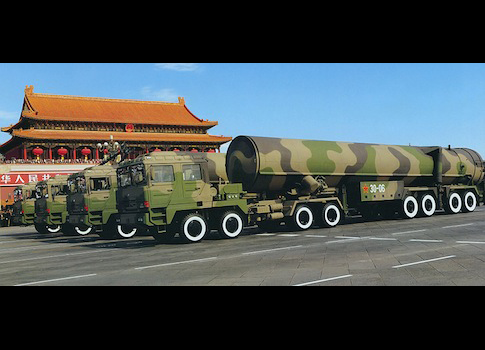China last week carried out a second flight test of a new long-range mobile missile that is capable of hitting United States cities with a nuclear warhead. The test took place days before North Korea is set to fire its long-range missile, according to U.S. intelligence officials.
U.S. intelligence airborne and space sensors detected the flight test Friday of the road-mobile DF-31A missile as it lifted off from the Wuzhai Space and Missile Test Center. The missile flew west to an impact range in western China.
It was the second DF-31A flight test since August and highlights China's growing strategic nuclear buildup, a modernization program largely carried out in secret.
The DF-31A test also took place on the last day of a rare U.S.-China military exercise in Chengdu that practiced joint disaster relief efforts.
China is known to use its missile tests to send political signals, as in 1996 when it bracketed Taiwan with missile flight tests that impacted north and south of the island prior to a presidential election.
Analysts say the DF-31A test likely was intended to bolster the Chinese military’s hardline stance toward the United States and particularly the U.S. military, regarded by Beijing as its main adversary.
The most recent DF-31 flight test occurred Aug. 30, also from Wuzhai, located in Shanxi province about 267 miles southwest of Beijing. That missile test involved a single warhead simulation.
However, on July 24 China conducted the first flight test of a newer road-mobile ICBM called the DF-41, which is assessed to be China’s first intercontinental ballistic missile to be equipped with multiple, independently-targetable warheads, or MIRVs.
The DF-31A was first deployed around 2007 and is believed to be capable of carrying up to five warheads. Its maximum range is up to 5,000 miles. There are some indications that the missile also may be deployed on rail cars disguised as passenger trains.
A Pentagon spokeswoman declined to comment on the missile launch, citing a policy of not discussing intelligence matters.
"We monitor carefully China's military developments and urge China to exhibit greater transparency regarding its capabilities and intentions," the spokeswoman told the Free Beacon.
A Defense Department spokesman said in August in response to the last DF-31A test that the Pentagon "continues to carefully monitor China’s military modernization efforts, including progress in developing its offensive missile force."
The United States is meanwhile seeking to cut both its missile and nuclear forces under President Barack Obama’s goal of seeking to eliminate nuclear weapons.
Obama said in a speech Monday at the National Defense University, "We’re moving closer to the future that we seek, a future where these weapons never threaten our children again, a future where we know the security and peace of a world without nuclear weapons."
Richard Fisher, a China military affairs specialist, said the Obama administration should make more information available to the public on China’s strategic nuclear modernization program. Doing so would avoid "a potential nuclear surprise" and make sure "more pressure is placed on China to become transparent in this area."
"From underground bases and launch pads near Qinghai, China, the DF-31A may have sufficient range to reach U.S. ICBM bases in North Dakota," Fisher said in an email.
The DF-31A development "suggests that China may be building toward a ‘counterstrike’ strategy that would require the secret buildup of many more missiles and warheads than suggested by public ICBM number estimates made available by the U.S. Intelligence Community," he said.
Fisher said China may be stockpiling large numbers of "reload" missiles for the mobile DF-31A launchers in its large-scale underground nuclear system, estimated to include 3,000 miles of tunnels.
Additionally, the Chinese government’s constant statements that its nuclear forces are limited to retaliation from a nuclear attack requiring only a small number of missiles are a deception.
"Continuously repeating a consistent message of deception while doing the complete opposite reflects a far older Chinese strategic culture," Fisher said.
Meanwhile, U.S. officials said a North Korean Taepodong-2 missile is in the final stages of preparation for a test flight that is expected to further raise tensions in the region.
The Taepodong-2 is being readied at a launch facility in North Korea and is being closely watched. U.S. officials said the launch could take place as early as Dec. 10. The last Taepodong-2 launch in April failed shortly after launch.
Georgetown University arms control specialist Phillip A. Karber said the most recent Chinese missile test highlight’s Beijing’s growing strategic arsenal.
"The Chinese commitment to modernizing the full array of their ballistic missile arsenal, from tactical to theater to strategic systems, is evidence of their national commitment to what they call the next revolution in military affairs," Karber said.
"It is ironic that at a time that they believe they’re riding the wave of the future, the United States has greatly reduced our ability to take advantage of ballistic missiles for our security."
Karber said the DF-31A is significant because it can strike cities in the continental United States with nuclear weapons.
The two-day U.S.-China military exercise involved U.S. and Chinese officers meeting at a Chinese military barracks in the central Chinese city of Chengdu and discussing how the two militaries would respond to an earthquake in a fictional third country, Associated Press reported Friday from Chengdu.
"I think it’s very conceivable. If there is a country out there, and there inevitably there will be, that will have a natural disaster, and they call for international help, if U.S. forces and Chinese forces respond, then indeed we’ll find ourselves working together in the field," U.S. Maj. Gen. Stephen Lyons told reporters.
